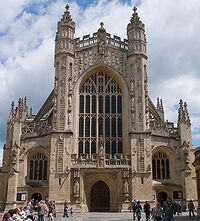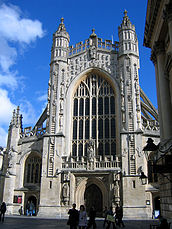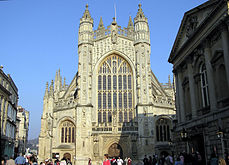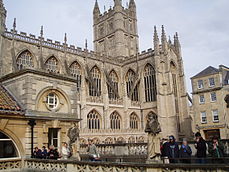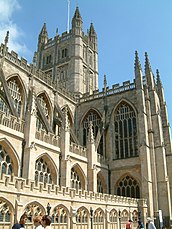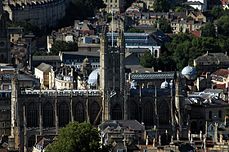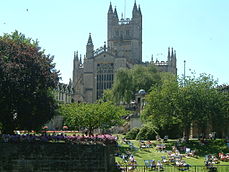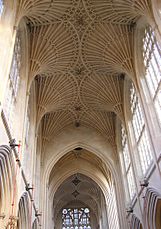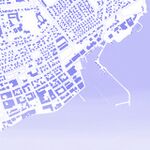Inscríbete y crea tu propia colección de obras y artículos
Diferencia entre revisiones de «Abadía de Bath»
Ir a la navegaciónIr a la búsqueda
m (Texto reemplaza - '{{l' a '{{L') |
m (Texto reemplaza - 'prior' a 'prior') |
||
| Línea 11: | Línea 11: | ||
Following the death of [[William the Conqueror]] in 1087, Bath was ravaged in the struggle for power between his sons. The victor, [[William Rufus]], granted the city to a royal [[physician]], [[John of Tours]], who became Bishop of [[Wells]] and [[Abbot]] of Bath.<ref name=Powicke205>{{Cite book | last= Powicke | first= Maurice | authorlink= F. M. Powicke | year= 1939 | title= Handbook of British Chronology | pages= pp. 205 | isbn= 0901050172}}</ref> | Following the death of [[William the Conqueror]] in 1087, Bath was ravaged in the struggle for power between his sons. The victor, [[William Rufus]], granted the city to a royal [[physician]], [[John of Tours]], who became Bishop of [[Wells]] and [[Abbot]] of Bath.<ref name=Powicke205>{{Cite book | last= Powicke | first= Maurice | authorlink= F. M. Powicke | year= 1939 | title= Handbook of British Chronology | pages= pp. 205 | isbn= 0901050172}}</ref> | ||
Permission was given to move the [[Episcopal see|see]] of Somerset from [[Wells Cathedral|Wells]] – a comparatively small settlement – to the then [[Defensive wall|walled]] [[city]] of Bath.<ref>{{Cite book | last= Barlow | first= Frank | authorlink = Frank Barlow (historian)| title= William Rufus | pages= pp.182 | publisher= Yale University Press | date= March 2000 | isbn= 0300082916}}</ref> | Permission was given to move the [[Episcopal see|see]] of Somerset from [[Wells Cathedral|Wells]] – a comparatively small settlement – to the then [[Defensive wall|walled]] [[city]] of Bath.<ref>{{Cite book | last= Barlow | first= Frank | authorlink = Frank Barlow (historian)| title= William Rufus | pages= pp.182 | publisher= Yale University Press | date= March 2000 | isbn= 0300082916}}</ref> | ||
This was effected in 1090. John therefore became the first Bishop of Bath, and St Peter's was raised to [[cathedral]] status. Since the roles of bishop and abbot had been combined, from then on the monastery was run by its | This was effected in 1090. John therefore became the first Bishop of Bath, and St Peter's was raised to [[cathedral]] status. Since the roles of bishop and abbot had been combined, from then on the monastery was run by its prior, and so became a [[priory]]. John of Tours planned a new cathedral on a grand scale, dedicated to [[Saint Peter]] and [[Paul the Apostle|Saint Paul]], but only the [[ambulatory]] was complete when he died in December 1122.<ref name=Powicke205/> He was buried in the cathedral.<ref name=BHOBath>{{Cite web | url= http://british-history.ac.uk/report.asp?compid=34341 | work= British History Online | title= Bishops of Bath and Wells 1066-1300 |accessdate= 2007-09-27}}</ref> | ||
The half-finished cathedral was devastated by fire in 1137, but work continued until about 1156; the completed building was approximately {{Convert|330|ft|m|0}} long. | The half-finished cathedral was devastated by fire in 1137, but work continued until about 1156; the completed building was approximately {{Convert|330|ft|m|0}} long. | ||
Revisión del 22:00 23 oct 2012
La Abadía de San Pedro en Bath (Somerset, Inglaterra), más conocida simplemente como Abadía de Bath es una iglesia anglicana, y anteriormente un monasterio Benedictino. Fundada en el siglo VII, reorganizada en el siglo X y reconstruida en los siglos XII|XII y XVI, es uno de los mayores ejemplos de Gótico perpendicular del sudoeste de Inglaterra. Se trata de una iglesia de planta cruciforme, con capacidad para aproximadamente 1.200 personas. Se emplea para servicios religiosos, ceremonias civiles y conferencias.[1]
Otras imágenes
Detalle de los ángeles que suben y bajan por la Escalera de Jacob, fachada oeste
Referencias
- ↑
Bath Abbey. Bath Abbey. Consultado el 2007-09-27.
Enlaces externos
Bath Abbey}}
